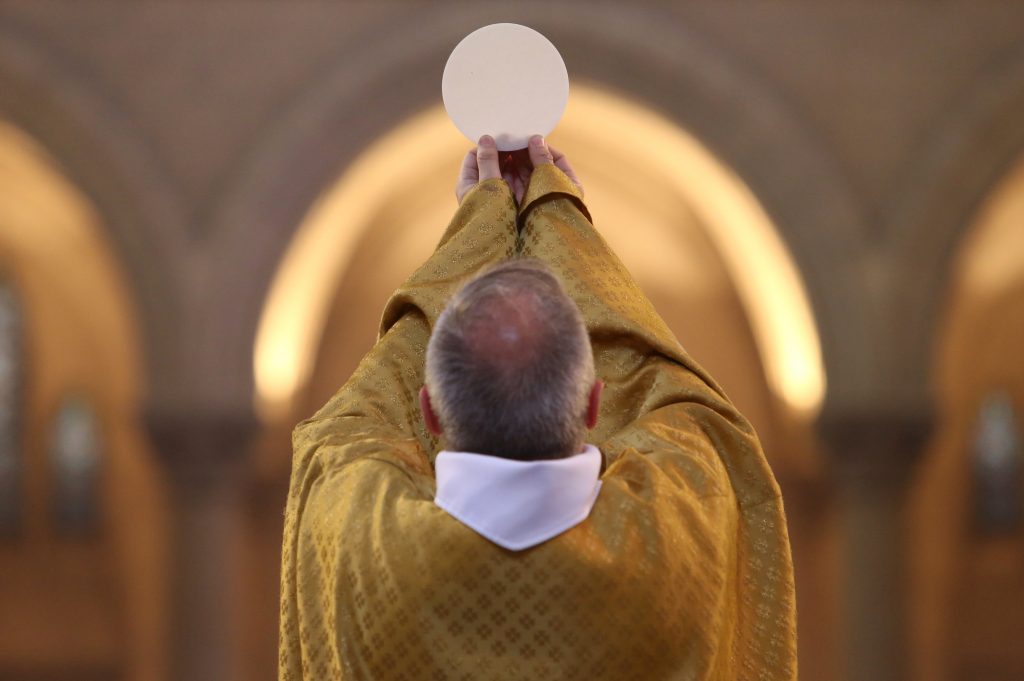“For some extraordinary reason, there is a fixed notion that it is more liberal to disbelieve in miracles than to believe in them. Why, I cannot imagine, nor can anybody tell me. For some inconceivable cause a ‘broad’ or ‘liberal’ clergyman always means a man who wishes at least to diminish the number of miracles; it never means a man who wishes to increase that number.”
— G.K. Chesterton, “Orthodoxy”
The Church teaches that “the Eucharist is ‘the source and summit of the Christian life.’ ” Without the transubstantiation, Christ is but a symbol. The Crucifixion and Resurrection are but metaphors. Communion is virtual reality, not the real body and blood of Our Lord.
Yet a 2019 Pew Research Center survey found — distressingly, astoundingly — that under a third of U.S. Catholics believe that “during Catholic Mass, the bread and wine actually become the body and blood of Jesus.”
“Transubstantiation” is defined by the Catechism as “the change of the whole substance of bread into the substance of the Body of Christ and of the whole substance of wine into the substance of his Blood. This change is brought about in the eucharistic prayer through the efficacy of the word of Christ and by the action of the Holy Spirit. However, the outward characteristics of bread and wine, that is the “eucharistic species,” remain unaltered” (CCC 283).
As with Mary’s question to the angel Gabriel: “How could this be?” (Luke 1:34).
But coming into the Church as a recovering alcoholic, for me the transubstantiation made perfect sense.
For almost two decades before getting sober I had been in total bondage. I craved a drink 24/7. My life was ordered to its smallest particularity around alcohol. There was no possible way I could have gone from that state to one day at rehab, over 36 years ago now, realizing that the obsession to drink had simply lifted. I was the same person, yet interiorly completely different. I was no longer slave to a malign master.
I hadn’t yet converted but I remember thinking: Oh, this is like the resurrection of Christ or Mary giving birth without ever having slept with Joseph. The transformation couldn’t have happened — and yet it had.
And because it had, I reflected upon it in the ensuing months and years from every angle. Clearly, it had been put in motion by something or Someone greater than me. I’d tried to stop a thousand times myself; the results had been nil.
Still, a miracle is no fairy tale. I hadn’t gotten better-looking, or skinnier, or younger; I hadn’t won the lottery. The transformation was psychological and spiritual. My center of gravity had shifted. My organizing principle had changed.
I couldn’t have effected the change myself, but neither did it occur against my will. It was as if on some deep subconscious level I had given permission. I had said Mary’s yes without knowing, as she didn’t, what the yes might mean.
Moreover, not only could the transformation not have happened, it really couldn’t have happened if I’d had to have first done something to deserve it.
Whatever had happened to me, in other words, was an act of total grace and mercy.
I was welcomed back to the human table: no questions asked; no account demanded or given. That came later — though even then, Christ never demanded it. Instead — another miracle — he led me to the Church.
So why does it matter whether we believe that, in the transubstantiation, the bread becomes the real body of Christ? For those of us who do believe, what does it mean? How does our belief manifest in our daily lives?
Reality becomes shot through with an added dimension. The kingdom of God becomes like yeast, all through the loaf (Matthew 13:33). We begin to see all of life as an ongoing journey of death and resurrection.
The fierce, self-giving love that arises in the heart of a new mother on fire with Christ is a kind of transubstantiation. The courage that nerves us to stand up for our faith in the face of public censure and ridicule is a kind of transubstantiation. The patient endurance that keeps us at our posts out of fidelity and obedience, however unglamorous those posts may be, is a kind of transubstantiation. Our outward species remains unchanged but inwardly, we’re being continually transformed.
A priest friend asks the rhetorical question: “How do you know it’s God?” Answer: Because it’s too good to be true. That the thing is too good to be true doesn’t mean it brings euphoria, success, or peace as the world knows peace.
The consent to the crucifixion of our own identities, desires, and wills opens the way to tremendous suffering in service to love.
That suffering becomes the point and purpose of our existence. And the Eucharist assures us that our love — all evidence often seeming to the contrary — bears abundant, everlasting fruit.
“To pick up a pin for love can convert a soul,” observed St. Thérèse of Lisieux. Christ’s sacrifice on Mount Calvary could convert the whole world, if only the world would consent to it.
“At the time he was betrayed and entered willingly into his Passion,” runs the eucharistic prayer. Praying for miracles, may we enter ever more willingly into ours.

